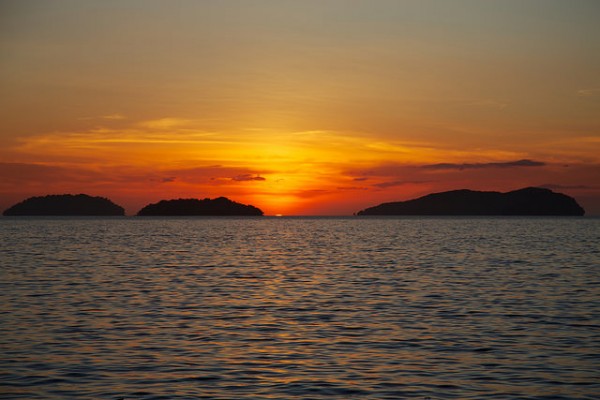
Sunset seen from Sabah, Malaysia over the South China Sea.
Photo by M. Edliadi for the Center for International Forestry Research (CIFOR).
On Mischief Reef, in the South China Sea just off the coast of the Philippine island of Palawan, Chinese workers are busy dredging sand and creating an island on top of partially-submerged coral reefs. The satellite images released last week, by the Asia Maritime Transparency Initiative at the Center for Strategic and International Studies, have drawn international attention to the island building boom undertaken by China which has accelerated in recent months.
The images have also focused the attention of U.S. President Barack Obama on the South China Sea territorial disputes, who spoke Thursday of a bullying Beijing intimidating its neighbors. “We think this can be solved diplomatically, but just because the Philippines or Vietnam are not as large as China doesn’t mean that they can just be elbowed aside,” Obama said during a visit to Jamaica. He also voiced concern over China “using its sheer size and muscle to force countries into subordinate positions.”
Beijing was quick to react to the criticism, with Foreign Ministry spokeswoman Hua Chunying responding, “I think you will agree with me that China has been a robust force for the preservation and promotion of peace and stability in the South China Sea.” She reiterated China’s “indisputable sovereignty over the Nansha Islands and their adjacent waters,” and offered to meet and discuss territorial claims with its neighbors Vietnam, Brunei, the Philippines and Malaysia, all of which have claims on the the fishing grounds and potential mineral reserves of the Nansha, or Spratly Islands.
Hua attempted to downplay the construction as an effort to provide peaceful maritime assistance during emergencies, but acknowledged the islands could also be used to “meet necessary demands” for defense.
Mischief Reef is not the only mischief Beijing has been up to — at Fiery Cross Reef, China is building a 3km-long airstrip to match its existing 2.7km airstrip on Woody Island in the Paracel Islands. On Hughes Reef, 75,000 square meters of sand have been dredged to allow for a new facility. More construction is expected on Gaven, Cuarteron and Eldad reefs.
To be fair, China is not the only nation constructing facts on the water. Vietnam has built 25 such features in the Spratly Island chain, and Taiwan is constructing a port for warships on Itu Aba (Taiping) — all in violation of a 2002 declaration by the Association of South-East Asian Nations (ASEAN) nations “to exercise self-restraint in the conduct of activities that would complicate or escalate disputes.”
Yet, China appears to be by far the most active in constructing new facts on the water, which have the potential for escalating disputes among nations competing for territory. Most nations in the region would share the concerns of U.S. Defense Secretary Ashton Carter, who advocates “no changes in the status quo are made coercively and that territorial disputes, which are long-standing, are not militarized.” The notion that China, with its large annual increases in military spending and active island construction, is “a robust force for the preservation and promotion of peace and stability in the South China Sea” has a long way to go before being accepted by a skeptical group of ASEAN neighbors.